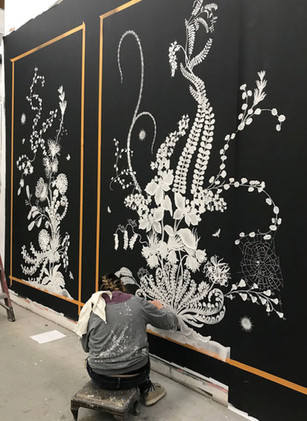Artelier Interview: Maria Apelo Cruz on creating MJ Atelier
- david
- Sep 9, 2022
- 5 min read
As international art consultants, Artelier specialises in curating art for luxury residential, hospitality, yacht and aviation projects. Artelier's feature wall collection – Artist Walls – presents a collection of artists whose originality of ideas and dedication to their materials makes them true contemporary masters. Through collaborating with Artelier, they have created large-scale custom art commissions that reinvent the concept of the mural for the modern age, pushing the possibilities for feature wall art.

MJ Atelier's innovative, patented technique for creating hand sculpted plaster wall art transcends the usual limitations for site-specific murals.
Crack resistant and durable, the decorative wall plaster artworks are crafted within the studio and shipped worldwide; this allows MJ Atelier to create monumental relief plaster feature walls that are uniquely created for each space and fit corner-to-corner, but are suitable for installation in a vast range of contexts.
In a two-part interview, Curator Alina Young speaks with the Founder and Creative Director of MJ Atelier, Maria Apelo Cruz.
Could you give a background to your career and how your current ideas have developed?
I was trained at the New York Academy of Art in New York City, in a pilot programme started by Andy Warhol and other art collectors and enthusiasts. This is way back in the early 80s, when they discovered that formal basic foundational training in the arts was extremely rare or did not exist.

So, we had the benefit of studying in the Renaissance tradition: they revived the old French academic curriculum, that had overtones of Renaissance training. There was a heavy emphasis on figure drawing, human and animal anatomy – we would dissect human cadavers at the morgue, and they even brought in a dead horse – no expense was spared to give students the same experience as a formally trained artist during the 18th and 19th centuries.
We studied Old Masters techniques and painting styles, and in the decorative arts we learned gilding, sculpture casting techniques, wood graining and marbleising. It was extremely hard-core training, which tried to revive all the lost world techniques. All these factors influence my work today.
The school also had a working atelier; we worked alongside professional artists who were creating murals, for really high-profile projects for New York City and internationally, working with some of the best architects of the time. Real training has more to do with working alongside other professional artists and learning the craft and the trade.
That's especially crucial for the decorative arts, which is the main focus of my work today. It is the reason we are able to take on just about anything designers request – there is no particular style, only ability. We are behind the scenes for many of the top designers in the world. We create, or are able to create, almost everything they dream up of, because we have this curious background training in decorative arts, and fine arts too. I minored in business as well, which helps keep the bottom line in check.

Leading on from your training, what led you to then develop MJ Atelier as it is now? Your current work blends traditional techniques with technological innovation to create site-specific, custom wall-coverings. How did that evolve?

I don't think my story is unique; after graduating, you search around and find where you fit. For me, I moved from NYC to Los Angeles, and I naturally found a niche for mural painting. There were movie industry studios that were looking for scenic painters. Not necessarily just scenic painting either – they’d need someone to create artworks integral to the storyline, so I would work directly with movie directors to create the paintings that were characters in the movie and so on. That went on for years!
It was then a natural extension to move into interior design. At that time, we had a huge project going on where I was fortunate enough to work with the last Heinsbergen, Tony Heinsbergen, who was who was being consulted on a new project called Pickfair in Beverly Hills (the old Hollywood estate of Mary Pickford and Douglas Fairbanks). It had enormous interiors with a vast amount of decorative plaster, art ceilings and gilding – it required all the skills that I had acquired.
I kept taking mural commissions and custom commissions within homes. After a while, of course, as decorative artists we get tired of being onsite and constantly moving around – it's fun, but it's also very, very taxing eventually. So, we developed this new, innovative wall-covering, which is a bas-relief format in modified plaster, that can be rolled and shipped worldwide.
You have a selection of signature MJ Atelier designs – are they very much your own designs, or were they developed as a team? What was the inspiration behind those designs in particular?
They’re my own designs. I tend to design for need, so these are what I interpret as concepts that never go out of style. They're solid. From there, people can get creative.
I’ve noticed that if you just put the product out there and say "Anything is possible", it stupefies people in a way. They say "Anything? I don't get it." Instead, you give them something to work from, and explain how "This is the standard chinoiserie" – which, by the way, is the standard throughout history!

You find examples of these types of formats in old palaces in England, Ireland, and in the great capitals of Europe.
We tend to put out some conservative designs like that; it’s acceptable for most people, and they really understand what it is when you give them something to work from.
From there, other designers collaborate to change it. They have the ability to see another, different vision, and can comment something like "I don't like those trees, let’s change them to something like this" or "Let's do something extremely modern and abstract". Those basic designs are springboards for creating new things.
Some examples of your work stick very closely to those designs, and some are completely different. For example, your recent project with Savage Interiors .
That design pays homage to the past and is based on Armand Rateau’s work, expressed through our new technique. It was the first time our technique was unveiled to a large crowd of professionals in the design industry – the Kips Bay show house in New York City. Designers often come to us and explain that they don't want to deviate too far from the original concept or idea from a certain era.
For example, we're working on a project at the moment for Wynn in Las Vegas, where they're working on a 1920s interior; everything we create has to look like it was made in the 20s, so out come the reference books. We try and create our designs with their intent in mind.
We are constantly creating innovative art and objects for the design industry – at the end of each day we consider ourselves truly blessed to be part of the manifestation of ideas and visions of others, that ultimately become interiors that uplift or transcend the everyday experience. For a decorative artist, it's heaven!
Maria Apelo Cruz and MJ Atelier are featured in Artelier's Artist Walls collection, and have a dedicated page on our website. To read more about MJ Atelier's innovative techniques, visit the first instalment of the interview here.
Artelier's art consultancy plays a fundamental role in all artwork commissions, and as the appointed art consultant for projects we bring artists and clients together to achieve forward-thinking and intelligently curated art installations. Discover more about our feature wall services: Artist Walls.















